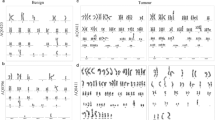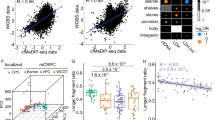Abstract
A critical region of loss of heterozygosity on human chromosome 13q14 harbors the tumor suppressor gene DICE1 (DDX26). To elucidate the reduced DICE1 expression in tumor cells, the putative promoter sequence upstream of the DICE1 gene was analysed. This sequence shows a high GC content and is rich in CpG sites and binding sites of transcriptional factors. Promoter activity was identified within three overlapping fragments of the 800 bp sequence upstream of the DICE1 gene. A 13 bp deletion polymorphism detected in the DICE1 promoter region showed a decreased activity compared with the undeleted variant. However, this 13 bp deletion was seen in male control samples and patients with prostate cancer or benign prostatic hyperplasia at similar rates. A reduced DICE1 expression was observed in prostate cancer cell lines DU145 and LNCaP. This downregulation is associated with hypermethylation of the DICE1 promoter. Treatment of both prostate cancer cell lines with 5-azacytidine leads to upregulation of DICE1 expression. Hypermethylation of CpG sites of the DICE1 promoter was observed in four of eight analysed prostate cancers. This study suggests that transcriptional repression of DICE1 is caused by hypermethylation of the DICE1 promoter region in prostate cancer cells.
This is a preview of subscription content, access via your institution
Access options
Subscribe to this journal
Receive 50 print issues and online access
$259.00 per year
only $5.18 per issue
Buy this article
- Purchase on SpringerLink
- Instant access to full article PDF
Prices may be subject to local taxes which are calculated during checkout






Similar content being viewed by others
References
Ausubel F (ed) (1989). Current Protocols in Molecular Biology Vol. 2. Unit 12.2. John Wiley & Sons: New York, Chichester, Brisbane, Toronto, Singapore.
Bird A . (2002). Genes Dev., 16, 6–21.
Böhm M, Schmidt C, Wieland I, Leclerc N and Allhoff EP . (1999). Onkologie, 22, 296–301.
Böhm M, Wieland I, Schütze K and Rübben H . (1997). Am. J. Pathol., 151, 63–67.
Deng G, Chen A, Pong E and Kim YS . (2001). Oncogene, 20, 7120–7127.
Dib C, Faure S, Fizames C, Samson D, Drouot N, Vignal A, Millasseau P, Marc S, Hazan J, Seboun E, Lathrop M, Gyapay G, Morissette J and Weissenbach J . (1996). Nature, 380, 152–154.
DiNardo DN, Butcher DT, Robinson DP, Archer TK and Rodenhiser DI . (2001). Oncogene, 20, 5331–5340.
Esteller M and Herman JG . (2002). J. Pathol., 196, 1–7.
Frommer M, McDonald LE, Millar DS, Collis CM, Watt F, Grigg GW, Molloy PL and Paul CL . (1992). Proc. Natl. Acad. Sci. USA, 89, 1827–1831.
Gardiner-Garden M and Frommer M . (1987). J. Mol. Biol., 196, 261–282.
Gibas Z, Becher R, Kawinski E, Horoszewicz J and Sandberg AA . (1984). Cancer Genet. Cytogenet., 11, 399–404.
Gleason DF, Nellinger GT and Veterans Administrative Cooperative Urological Research Group. (1974). J. Urol., 111, 58–64.
Gluzman Y . (1981). Cell, 23, 175–182.
Jones PA and Baylin SB . (2002). Nat. Rev. Genet., 3, 415–428.
Juttermann R, Li E and Jaenisch R . (1994). Proc. Natl. Acad. Sci. USA, 91, 11797–11801.
Klein G . (2002). Semin. Cancer Biol., 12, 327–330.
Kuroki T, Trapasso F, Yendamuri S, Matsuyama A, Alder H, Mori M and Croce CM . (2003). Cancer Res., 63, 3724–3728.
Li WJ, Hu N, Su H, Wang C, Goldstein AM, Wang Y, Emmert-Buck MR, Roth MJ, Guo WJ and Taylor PR . (2003). Oncogene, 22, 314–318.
Livak KJ and Schmittgen TW . (2001). Methods, 25, 402–408.
Ogawara K, Miyakawa A, Shiba M, Uzawa K, Watanabe T, Wang XL, Sato T, Kubosawa H, Kondo Y and Tanzawa H . (1998). Int. J. Cancer, 79, 312–317.
Rehfuss RP, Walton KM, Loriaux MM and Goodman RH . (1991). J. Biol. Chem., 266, 18431–18434.
Serrano M, Lee HW, Chin L, Cordon-Cardo C, Beach D and DePinho RA . (1996). Cell, 85, 27–37.
Sobin LH and Wittekind CH . (1997). Classification of malignant tomours, 5th ed. Wiley-Liss: New York, pp 170–173.
Stone KR, Mickey DD, Wunderli H, Mickey GH and Paulson DF . (1978). Int. J. Cancer, 21, 274–281.
Strathdee G . (2002). Semin. Cancer Biol., 12, 373–379.
Tamura K, Zhang X, Murakami Y, Hirohashi S, Xu HJ, Hu SX, Benedict WF and Sekiya T . (1997). Int. J. Cancer, 74, 45–49.
Ueda T, Emi M, Suzuki H, Komiya A, Akakura K, Ichikawa T, Watanabe M, Shiraishi T, Masai M, Igarashi T and Ito H . (1999). Genes, Chromsomes Cancer, 24, 183–190.
Watanabe T, Yokoo H, Yokoo M, Yonekawa Y, Kleihues P and Ohgaki H . (2001). J. Neuropathol. Exp. Neurol., 60, 1181–1189.
Wieland I, Arden KC, Michels D, Klein-Hitpass L, Böhm M, Viars CS and Weidle UH . (1999). Oncogene, 18, 4530–4537.
Wieland I, Röpke A, Stumm M, Sell C, Weidle UH and Wieacker PF . (2001). Oncol. Res., 12, 491–500.
Wieland I, Sell C, Weidle UH and Wieacker P . (2004). Oncol. Rep., 12, 207–211.
Wolf M, Mousses S, Hautaniemi S, Karhu R, Huusko P, Allinen M, Elkahloun A, Monni O, Chen Y, Kallioniemi A and Kallioniemi OP . (2004). Neoplasia, 6, 240–247.
Yang Q, Nakamura M, Nakamura Y, Yoshimura G, Suzuma T, Umemura T, Shimizu Y, Mori I, Sakurai T and Kakudo K . (2002). Clin. Cancer Res., 8, 2890–2893.
Yin Z, Spitz MR, Babaian RJ, Strom SS, Troncoso P and Kagan J . (1999). Oncogene, 18, 7576–7583.
Zöchbauer-Müller S, Fong KM, Maitra A, Lam S, Geradts J, Ashfaq R, Virmani AK, Milchgrub S, Gazdar AF and Minna JD . (2001). Cancer Res., 61, 3581–3585.
Acknowledgements
We thank Ms S Engelberg and Mr I Gläser for helpful technical assistance. This work was supported in part by the Dr-Mildred-Scheel Foundation.
Author information
Authors and Affiliations
Corresponding author
Rights and permissions
About this article
Cite this article
Röpke, A., Buhtz, P., Böhm, M. et al. Promoter CpG hypermethylation and downregulation of DICE1 expression in prostate cancer. Oncogene 24, 6667–6675 (2005). https://doi.org/10.1038/sj.onc.1208824
Received:
Revised:
Accepted:
Published:
Issue date:
DOI: https://doi.org/10.1038/sj.onc.1208824
Keywords
This article is cited by
-
Decoding the prognostic significance of integrator complex subunit 9 (INTS9) in glioma: links to TP53 mutations, E2F signaling, and inflammatory microenvironments
Cancer Cell International (2023)
-
Integrator complex subunit 6 (INTS6) inhibits hepatocellular carcinoma growth by Wnt pathway and serve as a prognostic marker
BMC Cancer (2017)



